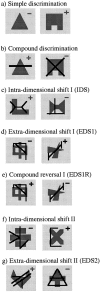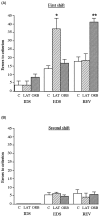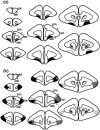Dissociable forms of inhibitory control within prefrontal cortex with an analog of the Wisconsin Card Sort Test: restriction to novel situations and independence from "on-line" processing
- PMID: 9364074
- PMCID: PMC6573594
- DOI: 10.1523/JNEUROSCI.17-23-09285.1997
Dissociable forms of inhibitory control within prefrontal cortex with an analog of the Wisconsin Card Sort Test: restriction to novel situations and independence from "on-line" processing
Abstract
Attentional set-shifting and discrimination reversal are sensitive to prefrontal damage in the marmoset in a manner qualitatively similar to that seen in man and Old World monkeys, respectively (Dias et al., 1996b). Preliminary findings have demonstrated that although lateral but not orbital prefrontal cortex is the critical locus in shifting an attentional set between perceptual dimensions, orbital but not lateral prefrontal cortex is the critical locus in reversing a stimulus-reward association within a particular perceptual dimension (Dias et al., 1996a). The present study presents this analysis in full and extends the results in three main ways by demonstrating that (1) mechanisms of inhibitory control and "on-line" processing are independent within the prefrontal cortex, (2) impairments in inhibitory control induced by prefrontal damage are restricted to novel situations, and (3) those prefrontal areas involved in the suppression of previously established response sets are not involved in the acquisition of such response sets. These findings suggest that inhibitory control is a general process that operates across functionally distinct regions within the prefrontal cortex. Although damage to lateral prefrontal cortex causes a loss of inhibitory control in attentional selection, damage to orbitofrontal cortex causes a loss of inhibitory control in affective processing. These findings provide an explanation for the apparent discrepancy between human and nonhuman primate studies in which disinhibition as measured on the Wisconsin Card Sort Test is associated with dorsolateral prefrontal damage, whereas disinhibition as measured on discrimination reversal is associated with orbitofrontal damage.
Figures






References
-
- Amaral DG, Price JL, Pitkanen A, Carmichael ST. The primate amygdala. In: Aggleton JP, editor. The amygdala. Wiley; New York: 1992. pp. 1–66.
-
- Brodmann K. Vergleichende lokalisationslehre der großhirnrinde in ihren prinzipierdargestellt auf grund des zellenbaues. Verlag Johan Ambrosius Barth; Leipzig: 1909.
-
- Butter CM. Impairments in selective attention to visual stimuli in monkeys with inferotemporal and lateral striate lesions. Brain Res. 1969;12:374–383. - PubMed
-
- Cicerone KD, Lazar RM. Effects of frontal lobe lesions on hypothesis sampling during concept formation. Neuropsychologia. 1983;21:513–524. - PubMed
-
- Courtney SM, Ungerleider LG, Keil K, Haxby JV. Object and spatial visual working memory activate separate neural systems in human cortex. Cereb Cortex. 1996;6:39–49. - PubMed
Publication types
MeSH terms
Substances
Grants and funding
LinkOut - more resources
Full Text Sources
Medical
